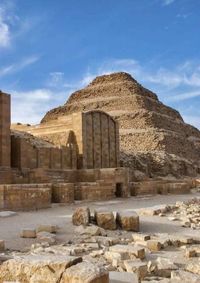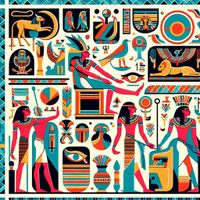On October 5, 2025, the Egyptian antiquities community was rocked by the announcement that a rare Pharaonic limestone painting had vanished from the tomb of Khentika in the Saqqara necropolis, just outside Cairo. This artwork, a relic of Egypt’s ancient Old Kingdom, has become the latest in a string of troubling disappearances from the country’s storied archaeological sites, raising urgent questions about the state of heritage protection in the land of the pharaohs.
According to Mohamed Ismail, secretary general of the Supreme Council of Antiquities, the missing painting was discovered to be absent during a recent check by a British archaeological mission in May 2025. The tomb itself, one of the few mastaba tombs in Saqqara to bear a written curse on its facade warning of divine retribution, had been sealed since 2019. Ismail stated that the painting was last seen that year, and its disappearance has prompted a formal investigation by Egyptian prosecutors. "There is information about the disappearance of an archaeological painting from one of the tombs in the Saqqara area, specifically from the famous tomb of 'Khentika', which is used as a storage for archaeological pieces," Dr. Magdy Shakir, chief archaeologist at the Ministry of Tourism and Antiquities, told local media, as cited by multiple Egyptian news outlets.
The missing artwork is no ordinary relic. Measuring approximately 40 by 60 centimeters and crafted from limestone, the painting dates back to the late Fifth or early Sixth Dynasty of the Old Kingdom, roughly between 2700 BC and 2200 BC. Its historical value is immense, not only for its age but for its content: the painting reportedly depicted the ancient Egyptian calendar, a system that divided the year into three distinct seasons reflecting the annual ebb and flow of the Nile River—Akhet (the flooding season), Proyat (the planting season), and Shomu (the harvest season). Egyptian media also reported that it included three scenes of daily life, offering a rare glimpse into the rhythms and rituals of ancient Egypt.
What makes the case even more perplexing is the timeline of the theft. An informed source at the Ministry of Tourism and Antiquities revealed, as reported by local websites, that the painting may have been missing or stolen for as long as six years—with its absence only discovered a few months ago. This revelation has prompted the Supreme Council of Antiquities and the Ministry of Tourism and Antiquities to launch a comprehensive inventory and assessment of storages across the site to determine the full extent of missing artifacts. "The relevant authorities, including the Supreme Council of Antiquities, are conducting a comprehensive inventory and assessment of the storages to know all the details," Dr. Shakir confirmed in response to the incident.
The Saqqara necropolis itself is no ordinary burial ground. Located south of the iconic Step Pyramid of Djoser and forming part of the vast Memphis necropolis complex, Saqqara is a UNESCO World Heritage site. It is home to a sprawling array of tombs, pyramids, and burial chambers, including smaller pyramids at Abu Sir, Dahshur, and Abu Ruwaysh. The tomb of Khentika, unearthed in the 1950s, stands out for its architectural and historical significance. Mastaba tombs like Khentika’s feature underground burial chambers and above-ground rooms for offerings, reflecting the intricate funerary practices of ancient Egypt. The curse inscribed on the facade—one of only a handful at Saqqara—warned would-be intruders of dire consequences, a testament to the value placed on such treasures even millennia ago. According to British Egyptologist Harry James, who co-authored a seminal paper on the tomb, these curses were meant to deter grave robbers and protect the sanctity of the resting place.
The disappearance of the Khentika painting is not an isolated event. Just weeks earlier, on September 9, 2025, an ancient gold bracelet belonging to Pharaoh Amenemope, who ruled around 3,000 years ago, was stolen from the Egyptian Museum in Cairo. The bracelet, adorned with a lapis lazuli bead, was taken while museum officials were preparing artifacts for an Italian exhibit. Authorities later revealed that the bracelet was spirited away from a restoration lab and passed through several dealers before being melted down—a fate that underscores the vulnerability of Egypt’s priceless heritage to theft and illicit trade. The theft of the bracelet sparked public outrage, echoing the lingering pain from the infamous 2010 theft of Vincent van Gogh’s "Poppy Flowers" from a Cairo museum, a painting valued at $50 million and still missing to this day.
These incidents have reignited debate within Egypt about the challenges of safeguarding its archaeological legacy. As reported by Devdiscourse and South China Morning Post, Egyptian media and officials have sounded the alarm over the continued threat to the nation’s cultural patrimony. The disappearance of the Khentika painting, alongside the recent bracelet theft, has brought renewed scrutiny to security protocols at museums and archaeological sites. Critics argue that chronic underfunding, insufficient staffing, and a thriving black market for antiquities have hampered efforts to protect Egypt’s treasures. Meanwhile, authorities insist they are taking the matter seriously, pointing to ongoing investigations and the launch of comprehensive audits at major sites.
In the words of a statement from the Supreme Council of Antiquities, the investigation into the Saqqara painting’s disappearance is ongoing, with prosecutors working to establish a timeline and identify any lapses in security. The council has also pledged to bolster oversight and improve inventory management at storages and museums nationwide. "An investigation is currently underway regarding the matter," one ministry source said, as reported by local outlets. For now, the fate of the Khentika painting remains a mystery, and the art world waits anxiously for any sign of its recovery.
The Saqqara incident is a sobering reminder that the story of Egypt’s ancient wonders is still being written—not only in the discoveries made by archaeologists, but in the ongoing struggle to protect and preserve a heritage that belongs not just to Egypt, but to humanity as a whole. As officials race to solve the latest mystery, the hope endures that the missing painting, like so many treasures before it, might one day return to its rightful place.





